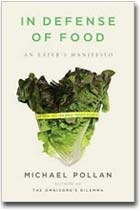Self-Care: What the President Didn’t Say
By
Jesse Kornbluth
Published: Sep 10, 2009
Category:
Health and Fitness
Depending on where you sit, President Obama’s speech about health care was either a long-overdue line in the sand or, as the Congressman from South Carolina would have it, a lie.
From where I sit, it was just the opening salvo in a much larger change in the way we live. What the President didn’t say: The American health care/medical industry is currently based on a sickness model. Big pharma makes its billions not by curing disease, but by managing and maintaining it. If, however, we evolved to a wellness model, we could really save a fortune on health care.
How would we do that?
Diet and exercise. (Like you didn’t know!)
Michael Pollan, dean of sanity on this subject, nailed this yet again in a
New York Times Op-Ed. Highlights:
According to the Centers for Disease Control and Prevention, three-quarters of health care spending now goes to treat “preventable chronic diseases.” Not all of these diseases are linked to diet — there’s smoking, for instance — but many, if not most, of them are.
We’re spending $147 billion to treat obesity, $116 billion to treat diabetes, and hundreds of billions more to treat cardiovascular disease and the many types of cancer that have been linked to the so-called Western diet. One recent study estimated that 30 percent of the increase in health care spending over the past 20 years could be attributed to the soaring rate of obesity, a condition that now accounts for nearly a tenth of all spending on health care.
Pollan’s conclusion: “One of the leading products of the American food industry has become patients for the American health care industry.”
But a change in the way we insure Americans will, says Pollan, inspire a second, as yet unnoted change in the attitude of our health insurers: “The moment these new rules take effect, health insurance companies will promptly discover they have a powerful interest in reducing rates of obesity and chronic diseases linked to diet.”
Will the insurance companies warn you about high-fructose corn syrup and commercial soft drinks and oversized portions at the fast food joints? Maybe. But why wait to be told what you already know? If you’re in danger of adding diabetes, heart disease and cancer to your troubles, get a jump on the future. And if you’re a model citizen, consider checking these resources to confirm that you’re living right.
EXERCISE
A doctor and his aging patient have 5 questions for you: Do you do aerobics for 45 minutes four days a week? Do you lift weights two other days each week? Have you stopped eating crap? Outside of your job, is there something you deeply care about? Do you have a life partner who really cares about you — or a bunch of good friends?
Andrew Weil’s hope for you: You’re healthy and vital right into your ’80s and ’90s, and then you get sick and die quickly, with your dignity — and your wits — intact. ‘The goal is compression of morbidity, not life extension.’
“The body builds the mind as well as itself. If you exercise your muscles, you practically flood your gray cells with fresh nutrients and growth factors.”
This gentle healing — and self-healing — process is also an easily learned stress reduction technique. Reiki master Pamela Miles: "Reiki opens an inner spiritual connection that can significantly change the way a person experiences life, a sense of connectedness that can help transform negative attitudes and create a sense of meaning and purpose."
FOOD
On page 153 of Michael Pollan’s instant classic, you’ll read that processors don’t make low-fat dairy products just by removing the fat. To restore the texture — to make the drink “milky” — they must add stuff, usually powdered milk. Did you know powdered milk contains oxidized cholesterol, said to be worse for your arteries than plain old cholesterol? And that removing the fat makes it harder for your body to absorb the fat-soluble vitamins that make milk a valuable food in the first place?
Nina Planck’s major proposition is that “traditional” food — “foods we’ve been eating for a long time” — is good for us. “Industrial” food — “recent and synthetic” — is bad for us.
“If every American ate just one meal a week (any meal) composed of locally and organically raised meats and produce, we would reduce our country’s oil consumption by over 1.1 million barrels of oil every week. That’s not gallons, but barrels.”
Super Natural Cooking
Heidi Swanson: “Although we think of granola as health food, many of the versions currently available are made with highly processed oils and refined sweeteners. My favorite granola is a mix of honey-and citrus-kissed oats toasted until golden and then tossed with a colorful selection of dried tropical fruits. It keeps well stored in a glass jar and makes a great housewarming gift. Serve with creamy, cultured yogurt and fresh fruit for a perfect pairing.”
[Thanks to Jan Barker for the prod.]


